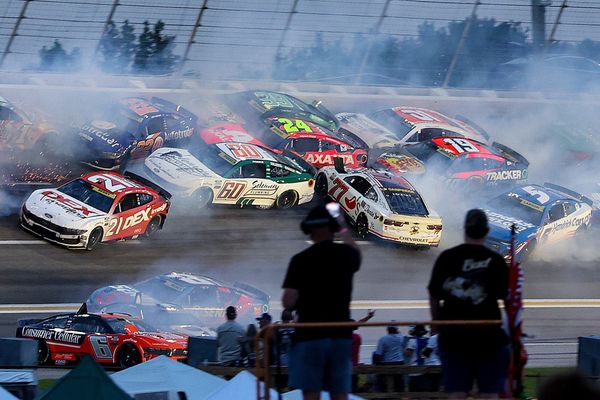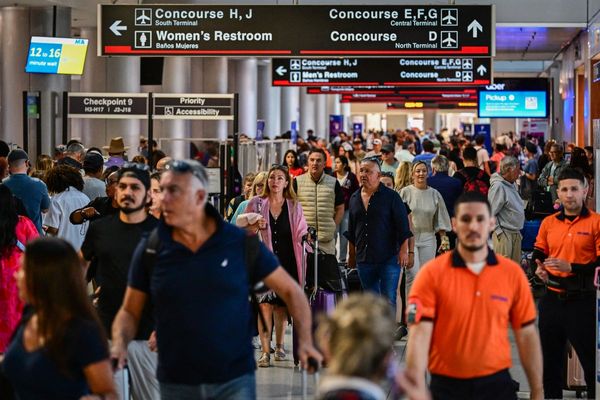/https://static.texastribune.org/media/files/b5867dd2232b53f8f7d0ceca17de2ddc/High%20Speed%20Rail%20HTX%20Dallas%20MS%20TT%2061.jpg)
A robust passenger rail system has long been seen as a pipe dream in car-dependent Texas.
But a glut of federal dollars for rail projects and a growing realization that road expansions won’t ease chronic congestion on the state’s busiest highways have some Texas officials and policymakers flirting once more with the idea of expanded passenger rail.
“It's like the perfect storm forming because 20 years ago if we talked about passenger rail in Texas, it would fall on deaf ears,” said Peter LeCody, who heads the organization Texas Rail Advocates.
Congress set aside $66 billion in the 2021 Infrastructure Investment and Jobs Act to advance rail projects across the country. That pot of funds has rekindled interest in exploring how to boost conventional passenger rail between Texas’ major urban areas and anticipate the transportation needs of the state’s booming population.
Texas has added hundreds of thousands of new residents in recent years, and the state’s population is projected to grow from 30 million people to 47 million by 2050. Without some form of reliable passenger rail between the cities, officials fear car dependence will grow and congestion will only get worse.
“The alternative is to condemn Americans to evermore crowded interstates, to condemn taxpayers to just paying for ever-widening of highways and potentially using evermore crowded airports,” Andy Byford, senior vice president of high-speed rail development at Amtrak, told reporters earlier this year.
At the epicenter of rail ambitions in Texas is the 10-year-old and embattled high-speed rail project between Dallas and Houston. The company behind the project, Texas Central, has long promised to ferry passengers between the two cities at speeds north of 200 miles per hour, which would pare down a 3.5-hour commute by automobile to a 90-minute ride by train car. The project lost steam for a time amid a leadership exodus and problems securing the land needed to build the system but Amtrak resurrected the plan last year.
Amtrak officials consider the route ideal for high-speed rail. It would connect two of the country’s largest metropolitan regions, which haven’t had any form of passenger rail between them since Amtrak shuttered a Dallas-Houston route in 1995. And it would run through relatively flat land, allowing the train to reach top speeds and travelers to bypass congestion on Interstate 45. What’s more, Amtrak officials believe the route could be the cornerstone for a potential national expansion of high-speed rail.
But while Texas’ chances of getting rail to connect its biggest cities are higher than they’ve been in years, lingering skepticism at the state level and local disagreements could still imperil the projects.
An “outlet valve” for traffic congestion
The Texas Department of Transportation recently obtained two federal grants to study how to boost passenger rail service on an existing Amtrak route from Houston to San Antonio and, in an effort separate from the Texas Central high-speed project, see if a conventional rail line between Houston and Dallas can be reinstated.
The agency wrote in the applications that increased congestion has made "highway travel unreliable" and boosting intercity passenger rail would remove hundreds of thousands of vehicles per year off Texas highways, easing congestion and hopefully traffic deaths. Expanding passenger rail would also help reduce greenhouse gas emissions, TxDOT noted.
Rapid population growth along the Interstate 35 corridor between Austin and San Antonio revived long-abandoned talks about how to boost the frequency and speed of passenger rail between the two cities. The Austin and San Antonio regions are projected to collectively grow from 5.2 million residents now to 8.3 million by 2050.
That growth will inevitably put further strain on I-35, already jam-packed with drivers who have no other way to travel between the two cities, said Travis County Judge Andy Brown and Bexar County Judge Peter Sakai, who formed a joint committee made up of local officials, transportation experts and rail advocates to explore how to expand passenger rail in Central Texas and perhaps beyond.
“It is unpredictable, it is unpleasant, it is unsafe to take that highway today in many cases,” Brown said. “And with the growth that we're seeing, I don't see how a highway is going to keep up.”
Sakai echoed Brown, stressing the need for some kind of “outlet valve” to relieve congestion along the corridor in the form of expanded passenger rail.
“I look at the reality that no matter how many lanes of traffic we build out on Interstate 35, it will never ever be large enough or have enough capacity,” Sakai said.
A split in Dallas-Fort Worth
With the push for expanding rail come disagreements over how to do so — and where to put it.
The most recent example is the debate over possibly extending Texas Central’s proposed Houston-to-Dallas line. The extension would stretch from a planned stop just south of downtown Dallas to Fort Worth, with a potential stop in Arlington. The pitch is intended to ensure the rest of the region has access to high-speed rail.
Fort Worth Mayor Mattie Parker and Arlington Mayor Jim Ross have backed the idea but it drew a rebuke from Dallas City Council members. The current plan would route the extension through a section of downtown Dallas, prompting fears among council members that it could upend redevelopment plans in the city’s urban core as well as siphon off economic growth to other parts of the region.
The council unanimously passed a resolution in June opposing above-ground passenger rail through downtown and commissioned a study measuring the economic impact of the proposed rail line extension.
“I understand what we are trying to accomplish but we get elected by the citizens of Dallas,” Dallas City Council Member Tennell Atkins, who authored the resolution, said at a June meeting. “If we don’t take care of Dallas, we’re going to be in trouble.”
In a bid to keep the extension project moving forward, planners with the North Central Texas Council of Governments, which coordinates transportation planning for the Dallas-Fort Worth region, tried to appease Dallas City Council members’ concerns. During a July 11 meeting of the metropolitan planning organization’s Regional Transportation Council, they presented a version of the route that would steer the rail line west of downtown Dallas.
“It's critical for me that if we're going to build a $6 billion project, we need to get it right,” Michael Morris, transportation director for the North Central Texas Council of Governments, said in an interview after the meeting. “We’ve got to get everyone on the same page.”
However, moving the line could delay the project’s federal environmental approval up to a year, which the agency needs in order to begin planning and financing work.
Whether the Dallas City Council will approve the change remains to be seen. Omar Narvaez, who chairs the Dallas City Council’s transportation committee, has supported the idea of having the rail line pass through downtown, noting that passengers would lose direct access to the convention center and other parts of downtown if the route moved. But he also said he wants to see the results of the council’s economic impact study, expected sometime early next year.
Dallas City Council Member Cara Mendelsohn, one of the council’s more conservative members who also serves on the Regional Transportation Council, said it doesn’t make sense to plan for a Dallas-to-Fort Worth line when the Texas Central route hasn’t cleared other hurdles to construction.
“We don't know that there will be any system,” Mendelsohn said during the July 11 meeting. “You don't know that Dallas to Houston will even happen. So this entire conversation seems extremely premature.”
The Dallas-Fort Worth region’s population is expected to grow from 8.1 million to more than 11 million by 2045. Given that growth, it only makes sense that high-speed rail will be built at some point, Morris said.
“Someone is going to build high-speed rail in the state of Texas,” Morris said. “To assume high-speed rail may never happen is not a logical step given the growth of Texas and the growth of the Dallas-Fort Worth region.”
A reality check for Texas
Even without local disagreements, the dream of Texans zipping reliably and frequently from city to city in a train car would still be far from reality. Rail advocates acknowledge that expanding or adding passenger rail anywhere in the state will be costly and require substantial public investment.
The state would have to pony up some amount of matching funds in order to obtain federal dollars to expand passenger rail along the corridors identified by TxDOT. But the Texas Constitution mandates that most of the agency’s budget must be spent on building and expanding freeways.
Lawmakers in the Republican-controlled Texas Legislature remain largely hostile to passenger rail and are unlikely to kick in state dollars to help pay for its expansion. Legislators even enacted a law in 2017 designed to prevent Texas Central from receiving state dollars to build high-speed rail, though the law was meant to apply to high-speed rail lines “operated by a private entity.” It’s not clear who would operate the Texas Central line, but Byford with Amtrak told the Dallas City Council earlier this year that company officials are proceeding as if Amtrak will run it.
State Rep. Terry Canales, an Edinburg Democrat who chairs the Texas House Transportation Committee, said he doesn’t foresee that lawmakers will budge on funding rail despite “once-in-a-lifetime” federal funding opportunities for such projects.
Morris said he expects a combination of federal and private funding will pay for the $6 billion Dallas-to-Fort Worth line. He said he would never expect the Legislature to chip in.
The Texas Central route also has other hurdles to clear. The Dallas-to-Houston route, first unveiled in 2014, still has to gain federal approval and find more than $30 billion in financing — expected to be at least partially covered by federal and private sources. That’s up from an earlier $12 billion estimate.
Another hurdle: land. Byford told reporters earlier this year that Texas Central has acquired about 30% of the land needed to build the line. While Byford said some landowners in the projected path are open to selling, he acknowledged others are still steadfastly opposed. The Texas Supreme Court has granted Texas Central the authority to seize land through eminent domain, but Byford has maintained that option will be a last resort.
Waller County Judge Trey Duhon, who heads Texans Against High-Speed Rail, an organization that opposes the Texas Central plan, said it’s possible the Dallas-to-Houston line would need to clear a new environmental review to account for population growth along the route.
More than anything, he said, residents in and along the proposed path need clarity on whether the project is actually moving forward.
“These people have been dealing with this for 10 years,” Duhon said. “There should come a point in time when enough is enough.”
Disclosure: Texas Central has been a financial supporter of The Texas Tribune, a nonprofit, nonpartisan news organization that is funded in part by donations from members, foundations and corporate sponsors. Financial supporters play no role in the Tribune's journalism. Find a complete list of them here.
Big news: director and screenwriter Richard Linklater; NPR President and CEO Katherine Maher; U.S. Rep. Pete Aguilar, D-California; and Luci Baines Johnson will take the stage at The Texas Tribune Festival, Sept. 5–7 in downtown Austin. Buy tickets today!







